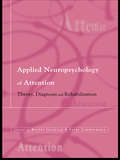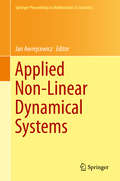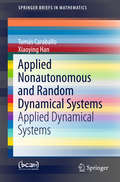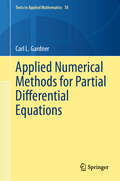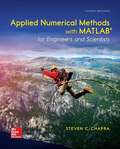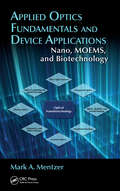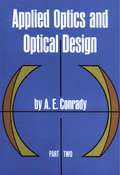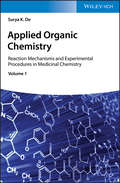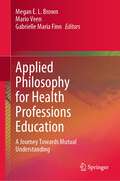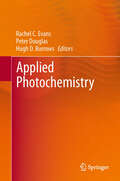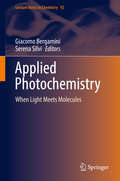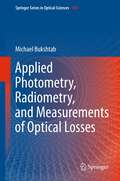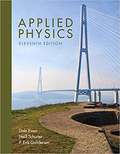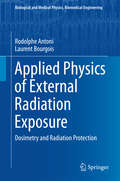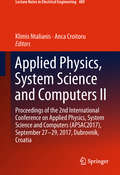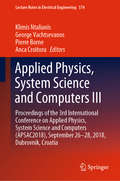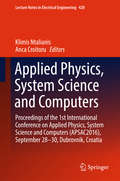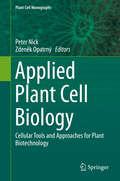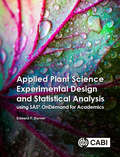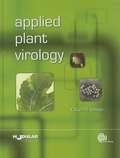- Table View
- List View
Applied Neurogenomics (Neuromethods #97)
by Kewal K. JainThis detailed volume reflects the considerable new developments that have taken place in the area of applied neurogenomics, particularly with the rapid progress in next generation sequencing. Beginning with an introduction to the technologies relevant to neurogenomics with an emphasis on next generation sequencing, the book also covers detailed methods relevant to the genomics of neurodegenerative diseases, particularly Alzheimer's disease and Huntington's disease, targeted sequencing of psychiatric disorders, as well as the role of genomics in the development of personalized neurology. Written in the popular Neuromethods series format, chapters provide the kind of practical description and implementation advice necessary to consistently produce successful results in the lab. Timely and convenient, Applied Neurogenomics serves as an invaluable reference for researchers working in this expanding, dynamic field.
Applied Neuropsychology of Attention: Theory, Diagnosis and Rehabilitation
by Peter Zimmermann Michel LeclercqThe concept of attention in academic psychology has been treated with varying degrees of importance over the years. From playing a key role in the 19th century, it was discarded in the first half of the 20th century, as clinical psychologists claimed it was superfluous to the essential subconscious processes of the mind, and experimental psychologists thought it was not a scientific term. Applied Neuropsychology of Attention aims to review the considerable developments in the field of attention over the last 20 years as it makes its comeback.This collection of essays forms a comprehensive overview of this crucial component of human cognitive function. The book begins with an explanation of the essential theoretical concepts and definitions. Aspects of diagnosis are then discussed as the assessment and impairments of attention are reviewed in normal ageing and in specific neurological categories. Victims of brain injury and patients with cerebrovascular or neurodegenerative diseases are considered. A critical analysis of existing practices in cognitive rehabilitation is given and a review of the techniques and methodologies used for treating attentional disturbances brings the book to a conclusion.Leclercq and Zimmermann have compiled a book of cutting-edge research which provides an effective framework to detect, analyse and understand the nature of attention deficit. The book will be invaluable to clinicians, mental health specialists and all academic psychologists in the field.
Applied Non-Linear Dynamical Systems (Springer Proceedings in Mathematics & Statistics #93)
by Jan AwrejcewiczThe book is a collection of contributions devoted to analytical, numerical and experimental techniques of dynamical systems, presented at the International Conference on Dynamical Systems: Theory and Applications, held in Å ódź, Poland on December 2-5, 2013. The studies give deep insight into both the theory and applications of non-linear dynamical systems, emphasizing directions for future research. Topics covered include: constrained motion of mechanical systems and tracking control; diversities in the inverse dynamics; singularly perturbed ODEs with periodic coefficients; asymptotic solutions to the problem of vortex structure around a cylinder; investigation of the regular and chaotic dynamics; rare phenomena and chaos in power converters; non-holonomic constraints in wheeled robots; exotic bifurcations in non-smooth systems; micro-chaos; energy exchange of coupled oscillators; HIV dynamics; homogenous transformations with applications to off-shore slender structures; novel approaches to a qualitative study of a dissipative system; chaos of postural sway in humans; oscillators with fractional derivatives; controlling chaos via bifurcation diagrams; theories relating to optical choppers with rotating wheels; dynamics in expert systems; shooting methods for non-standard boundary value problems; automatic sleep scoring governed by delay differential equations; isochronous oscillations; the aerodynamics pendulum and its limit cycles; constrained N-body problems; nano-fractal oscillators and dynamically-coupled dry friction.
Applied Nonautonomous and Random Dynamical Systems: Applied Dynamical Systems (SpringerBriefs in Mathematics)
by Tomás Caraballo Xiaoying HanThis book offers an introduction to the theory of non-autonomous and stochastic dynamical systems, with a focus on the importance of the theory in the Applied Sciences. It starts by discussing the basic concepts from the theory of autonomous dynamical systems, which are easier to understand and can be used as the motivation for the non-autonomous and stochastic situations. The book subsequently establishes a framework for non-autonomous dynamical systems, and in particular describes the various approaches currently available for analysing the long-term behaviour of non-autonomous problems. Here, the major focus is on the novel theory of pullback attractors, which is still under development. In turn, the third part represents the main body of the book, introducing the theory of random dynamical systems and random attractors and revealing how it may be a suitable candidate for handling realistic models with stochasticity. A discussion of future research directions serves to round out the coverage.
Applied Numerical Methods for Partial Differential Equations (Texts in Applied Mathematics #78)
by Carl L. GardnerThe aim of this book is to quickly elevate students to a proficiency level where they can solve linear and nonlinear partial differential equations using state-of-the-art numerical methods. It covers numerous topics typically absent in introductory texts on ODEs and PDEs, including: Computing solutions to chaotic dynamical systems with TRBDF2 Simulating the nonlinear diffusion equation with TRBDF2 Applying Newton’s method and GMRES to the nonlinear Laplace equation Analyzing gas dynamics with WENO3 (1D Riemann problems and 2D supersonic jets) Modeling the drift-diffusion equations with TRBDF2 and PCG Solving the classical hydrodynamic model (electro-gas dynamics) with WENO3 and TRBDF2 The book features 34 original MATLAB programs illustrating each numerical method and includes 93 problems that confirm results discussed in the text and explore new directions. Additionally, it suggests eight semester-long projects. This comprehensive text can serve as the basis for a one-semester graduate course on the numerical solution of partial differential equations, or, with some advanced material omitted, for a one-semester junior/senior or graduate course on the numerical solution of ordinary and partial differential equations. The topics and programs will be of interest to applied mathematicians, engineers, physicists, biologists, chemists, and more.
Applied Numerical Methods with MATLAB for Engineers and Scientists
by Steven C. ChapraApplied Numerical Methods with MATLAB is written for students who want to learn and apply numerical methods in order to solve problems in engineering and science. As such, the methods are motivated by problems rather than by mathematics. That said, sufficient theory is provided so that students come away with insight into the techniques and their shortcomings. McGraw-Hill's Connect, is also available as an optional, add on item. Connect is the only integrated learning system that empowers students by continuously adapting to deliver precisely what they need, when they need it, how they need it, so that class time is more effective. Connect allows the professor to assign homework, quizzes, and tests easily and automatically grades and records the scores of the student's work. Problems are randomized to prevent sharing of answers an may also have a "multi-step solution" which helps move the students' learning along if they experience difficulty.
Applied Optics Fundamentals and Device Applications: Nano, MOEMS, and Biotechnology
by Mark A. MentzerHow does the field of optical engineering impact biotechnology? Perhaps for the first time, Applied Optics Fundamentals and Device Applications: Nano, MOEMS, and Biotechnology answers that question directly by integrating coverage of the many disciplines and applications involved in optical engineering, and then examining their applications in nanobiotechnology. Written by a senior U.S. Army research scientist and pioneer in the field of optical engineering, this book addresses the exponential growth in materials, applications, and cross-functional relevance of the many convergent disciplines making optical engineering possible, including nanotechnology, MEMS, (MOEMS), and biotechnology. Integrates Coverage of MOEMS, Optics, and Nanobiotechnology—and Their Market Applications Providing an unprecedented interdisciplinary perspective of optics technology, this book describes everything from core principles and fundamental relationships, to emerging technologies and practical application of devices and systems—including fiber-optic sensors, integrated and electro-optics, and specialized military applications. The author places special emphasis on: Fiber sensor systems Electro-optics and acousto-optics Optical computing and signal processing Optical device performance Thin film magnetic memory MEMS, MOEMS, nano- and bionanotechnologies Optical diagnostics and imaging Integrated optics Design constraints for materials, manufacturing, and application space Bridging the technology gaps between interrelated fields, this reference is a powerful tool for students, engineers and scientists in the electrical, chemical, mechanical, biological, aerospace, materials, and optics fields. Its value also extends to applied physicists and professionals interested in the relationships between emerging technologies and cross-disciplinary opportunities. Author Mark A. Mentzer is a pioneer in the field of optical engineering. He is a senior research scientist at the U.S. Army Research Laboratory in Maryland. Much of his current work involves extending the fields of optical engineering and solid state physics into the realm of biochemistry and molecular biology, as well as structured research in biophotonics.
Applied Optics and Optical Design, Part One
by A. E. Conrady"For the optical engineer it is an indispensable work." -- Journal, Optical Society of America"As a practical guide this book has no rival." -- Transactions, Optical Society"A noteworthy contribution," -- Nature (London)Part I covers allordinary ray-tracing methods, together with the complete theory of primary aberrations and as much of higher aberration as is needed for the design of telescopes, low-power microscopes and simple optical systems. Chapters: Fundamental Equations, Spherical Aberration, Physical Aspect of Optical Images, Chromatic Aberration, Design of Achromatic Object-Glasses, The Optical Sine Theorem, Trigonometric Tracing of Oblique Pencils, General Theory of Perfect Optical Systems, and Ordinary Eyepieces.Part II extends the coverage to the systematic study and design of practically all types of optical systems, with special attention to high-power microscope objectives and anastigmatic photographic objectives. Edited and completed from the author s manuscript by Rudolf Kingslake, Director of Optical Design, Eastman Kodak Company. Chapters: Additional Solutions by the Thin-Lens Method , Optical Path Differences, Optical Path Differences at an Axiallmage Point, Optical Tolerances, Chromatic Aberration as an Optical Path Difference, The Matching Principle and the Design of Microscope Objectives, Primary Aberrations of Oblique Pencils, Analytical Solutions for Simple Systems with Remote Stop, Symmetrical Photographic Objectives, and Unsymmetrical Photographic Objectives.
Applied Optics and Optical Design, Part Two (Dover Books on Physics)
by A. E. Conrady"For the optical engineer it is an indispensable work." -- Journal, Optical Society of America"As a practical guide this book has no rival." -- Transactions, Optical Society"A noteworthy contribution," -- Nature (London)This two-volume paperback republication of A. E. Conrady's classic work presents his complete system of optical design. The only work of its kind in English, this set leads the reader step by step from the fundamental concepts of geometrical and physical optics up to the point where he can design the simpler optical systems without aid. It remains the only detailed work on the subject written with the needs of the practical designer and the self-taught constantly in mind. For most of the text, no mathematics above trigonometry is needed; occasional sections require some calculus and analytical geometry.Part I covers all ordinary ray-tracing methods, together with the complete theory of primary aberrations and as much of higher aberration as is needed for the design of telescopes, low-power microscopes and simple optical systems. Chapters: Fundamental Equations, Spherical Aberration, Physical Aspect of Optical Images, Chromatic Aberration, Design of Achromatic Object-Glasses, Extra-Axial Image Points, The Optical Sine Theorem, Trigonometric Tracing of Oblique Pencils, General Theory of Perfect Optical Systems, and Ordinary Eyepieces.Part II extends the coverage to the systematic study and design of practically all types of optical systems, with special attention to high-power microscope objectives and anastigmatic photographic objectives. Edited and completed from the author's manuscript by Rudolf Kingslake, Director of Optical Design, Eastman Kodak Company. Chapters: Additional Solutions by the Thin-Lens Method, Optical Path Differences, Optical Path Differences at an Axial Image Point, Optical Tolerances, Chromatic Aberration as an Optical Path Difference, The Matching Principle and the Design of Microscope Objectives, Primary Aberrations of Oblique Pencils, Analytical Solutions for Simple Systems with Remote Stop, Symmetrical Photographic Objectives, and Unsymmetrical Photographic Objectives.
Applied Organic Chemistry: Reaction Mechanisms and Experimental Procedures in Medicinal Chemistry
by Surya K. DeAn indispensable guide for all synthetic chemists who want to learn about the most relevant reactions and reagents employed to synthesize important heterocycles and drugs! The synthesis of natural products, bioactive compounds, pharmaceuticals, and drugs is of fundamental interest in modern organic chemistry. New reagents and reaction methods towards these molecules are being constantly developed. By understanding the mechanisms involved and scope and limitations of each reaction applied, organic chemists can further improve existing reaction protocols and develop novel efficient synthetic routes towards frequently used drugs, such as Aspirin or Penicillin. Applied Organic Chemistry provides a summary of important (name) reactions and reagents applied in modern organic chemistry and drug synthesis. It covers rearrangement, condensation, olefination, metathesis, aromatic electrophilic substitutions, Pd-catalyzed C-C bond forming reactions, multi-component reactions, as well as oxidations and reductions. Each chapter is clearly structured, providing valuable information on reaction details, step-by-step mechanism, experimental procedures, applications, and (patent) references. By providing mechanistic information and representative experimental procedures, this book is an indispensable guide for researchers and professionals in organic chemistry, natural product synthesis, pharmaceutical, and medicinal chemistry, as well as post-graduates preparing themselves for a job in the pharmaceutical industry. Hot Topic: Reviews important classes of organic reactions (incl. name reactions) and reagents in medicinal chemistry. Useful: Provides information on reaction details, common reagents, and functional group transformations used to synthesize natural products, bioactive compounds, drugs, and pharmaceuticals, e.g. Aspirin, Penicillin. Unique: For every reaction the mechanism is explained step by step, and representative experimental procedures are given, unlike most books in this area. User-friendly: Chapters are clearly structured making it easy for the reader to compare different reactions. Applied Organic Chemistry is an indispensable guide for researchers and professionals in organic chemistry, natural product synthesis, pharmaceutical, and medicinal chemistry, as well as post-graduates preparing themselves for a job in the pharmaceutical industry.
Applied Parameter Estimation for Chemical Engineers
by Peter Englezos Nicolas KalogerakisThis book determines adjustable parameters in mathematical models that describe steady state or dynamic systems, presenting the most important optimization methods used for parameter estimation. It focuses on the Gauss-Newton method and its modifications for systems and processes represented by algebraic or differential equation models.
Applied Philosophy for Health Professions Education: A Journey Towards Mutual Understanding
by Megan E. L. Brown Mario Veen Gabrielle Maria FinnThis book increases the accessibility of philosophical concepts to a wider audience within medical education, translating ‘knowing’ to ‘doing.’ It prompts health professions educators and researchers to consider the dynamics and structure of contemporary issues within health professions education in new, philosophical ways. Through considering the practical implications of applying philosophical concepts to contemporary issues, the book recommends avenues for further research and pedagogical change. Individual educators are considered, with practice points for teaching generated within each chapter. Readers will acquire practical ways in which they can change their own practice or pedagogy that align with the new insight offered through our philosophical analysis. These practical recommendations may be systemic in nature, but the authors of this book also offer micro-level recommendations for practitioners that can be considered as ways to improve individual approaches to education and research.
Applied Photochemistry
by Peter Douglas Hugh D. Burrow Rachel C. EvansApplied Photochemistry encompasses the major applications of the chemical effects resulting from light absorption by atoms and molecules in chemistry, physics, medicine and engineering, and contains contributions from specialists in these key areas. Particular emphasis is placed both on how photochemistry contributes to these disciplines and on what the current developments are.The book starts with a general description of the interaction between light and matter, which provides the general background to photochemistry for non-specialists. The following chapters develop the general synthetic and mechanistic aspects of photochemistry as applied to both organic and inorganic materials, together with types of materials which are useful as light absorbers, emitters, sensitisers, etc. for a wide variety of applications. A detailed discussion is presented on the photochemical processes occurring in the Earth's atmosphere, including discussion of important current aspects such as ozone depletion. Two important distinct, but interconnected, applications of photochemistry are in photocatalytic treatment of wastes and in solar energy conversion. Semiconductor photochemistry plays an important role in these and is discussed with reference to both of these areas. Free radicals and reactive oxygen species are of major importance in many chemical, biological and medical applications of photochemistry, and are discussed in depth. The following chapters discuss the relevance of using light in medicine, both with various types of phototherapy and in medical diagnostics. The development of optical sensors and probes is closely related to diagnostics, but is also relevant to many other applications, and is discussed separately. Important aspects of applied photochemistry in electronics and imaging, through processes such as photolithography, are discussed and it is shown how this is allowing the increasing miniaturisation of semiconductor devices for a wide variety of electronics applications and the development of nanometer scale devices. The final two chapters provide the basic ideas necessary to set up a photochemical laboratory and to characterise excited states. This book is aimed at those in science, engineering and medicine who are interested in applying photochemistry in a broad spectrum of areas. Each chapter has the basic theories and methods for its particular applications and directs the reader to the current, important literature in the field, making Applied Photochemistry suitable for both the novice and the experienced photochemist.
Applied Photochemistry: When Light Meets Molecules (Lecture Notes in Chemistry #92)
by Serena Silvi Giacomo BergaminiThis monograph features what happens when light meets molecules. This edited volume contains contributions from an international array of contributors, and it is divided into sections representing a selection of carefully focussed and connected photochemistry topics: energy, technology, medicine, environmental sciences, and art. In each section one or more chapters illustrates relevant aspects of each field, such as artificial photosynthesis and solar energy conversion (energy), light emitting devices and photochromic dyes (technology), and photodynamic therapy and solar filters (medicine). Aimed at students of all levels and researchers active in photochemistry.
Applied Photometry, Radiometry, and Measurements of Optical Losses (Springer Series in Optical Sciences #163)
by Michael BukshtabApplied Photometry, Radiometry, and Measurements of Optical Losses reviews and analyzes physical concepts of radiation transfer, providing quantitative foundation for the means of measurements of optical losses, which affect propagation and distribution of light waves in various media and in diverse optical systems and components. The comprehensive analysis of advanced methodologies for low-loss detection is outlined in comparison with the classic photometric and radiometric observations, having a broad range of techniques examined and summarized: from interferometric and calorimetric, resonator and polarization, phase-shift and ring-down decay, wavelength and frequency modulation to pulse separation and resonant, acousto-optic and emissive - subsequently compared to direct and balancing methods for studying free-space and polarization optics, fibers and waveguides. The material is focused on applying optical methods and procedures for evaluation of transparent, reflecting, scattering, absorbing, and aggregated objects, and for determination of power and energy parameters of radiation and color properties of light.
Applied Physics
by P. Erik Gundersen Neill Schurter Dale EwenApplied Physics, 11th Edition presents clear, to-the-point, topical coverage of basic physics applied to industrial and technical fields. Throughout the text, emphasis is placed on teaching students to use a consistent problem-solving methodology. A wealth of real-world applications are presented, motivating students by teaching physics concepts in context. Updated with new color photos, clarifications, and enhancements, the Eleventh Edition also features sections on physics-related careers and new technologies to engage readers in the material.
Applied Physics of External Radiation Exposure: Dosimetry and Radiation Protection (Biological and Medical Physics, Biomedical Engineering)
by Rodolphe Antoni Laurent BourgoisThis book describes the interaction of living matter with photons, neutrons, charged particles, electrons and ions. The authors are specialists in the field of radiation protection. The book synthesizes many years of experiments with external radiation exposure in the fields of dosimetry and radiation shielding in medical, industrial and research fields. It presents the basic physical concepts including dosimetry and offers a number of tools to be used by students, engineers and technicians to assess the radiological risk and the means to avoid them by calculating the appropriate shields. The theory of radiation interaction in matter is presented together with empirical formulas and abacus. Numerous numerical applications are treated to illustrate the different topics. The state of the art in radiation protection and dosimetry is presented in detail, especially in the field of simulation codes for external exposure to radiation, medical projects and advanced research. Moreover, important data spread in different up to date references are presented in this book. The book deals also with accelerators, X-rays facilities, sealed sources, dosimetry, Monte Carlo simulation and radiation regulation. Each chapter is split in two parts depending on the level of details the readers want to focus on. The first part, accessible to a large public, provides a lot of simple examples to help understanding the physics concepts under radiation external exposure. The second part, called "Additional Information" is not mandatory; it aims on explaining topics more deeply, often using mathematical formulations. The book treats fundamental radiometric and dosimetric quantities to describe the interaction in materials under the aspects of absorbed dose processes in tissues. Definitions and applications on limited and operational radiation protection quantities are given. An important aspect are practical engineering tools in industrial, medical and research domains. Source characterization and shielding design are addressed. Also more "exotic" topics, such as ultra intense laser and new generation accelerators, are treated. The state of the art is presented to help the reader to work with the book in a self-consistent way. The basic knowledge necessary to apply Monte Carlo methods in the field of radiation protection and dosimetry for external radiation exposure is provided. Coverage of topics such as variance reduction, pseudo-random number generation and statistic estimators make the book useful even to experienced Monte Carlo practitioners. Solved problems help the reader to understand the Monte Carlo process. The book is meant to be used by researchers, engineers and medical physicist. It is also valuable to technicians and students.
Applied Physics, System Science and Computers II: Proceedings of the 2nd International Conference on Applied Physics, System Science and Computers (APSAC2017), September 27-29, 2017, Dubrovnik, Croatia (Lecture Notes in Electrical Engineering #489)
by Klimis Ntalianis Anca CroitoruThis book reports on advanced theories and methods in three related fields of research: applied physics, system science and computers. It is organized in three parts, the first of which covers applied physics topics, including lasers and accelerators; condensed matter, soft matter and materials science; nanoscience and quantum engineering; atomic, molecular, optical and plasma physics; as well as nuclear and high-energy particle physics. It also addresses astrophysics, gravitation, earth and environmental science, as well as medical and biological physics. The second and third parts focus on advances in computers and system science, respectively, and report on automatic circuit control, power systems, computer communication, fluid mechanics, simulation and modeling, software engineering, data structures and applications of artificial intelligence among other areas. Offering a collection of contributions presented at the 2nd International Conference on Applied Physics, System Science and Computers (APSAC), held in Dubrovnik, Croatia on September 27–29, 2017, the book bridges the gap between applied physics and electrical engineering. It not only to presents new methods, but also promotes collaborations between different communities working on related topics at the interface between physics and engineering, with a special focus on communication, data modeling and visualization, quantum information, applied mechanics as well as bio and geophysics.
Applied Physics, System Science and Computers III: Proceedings of the 3rd International Conference on Applied Physics, System Science and Computers (APSAC2018), September 26-28, 2018, Dubrovnik, Croatia (Lecture Notes in Electrical Engineering #574)
by Pierre Borne Klimis Ntalianis Anca Croitoru George VachtsevanosThis book reports on advanced theories and methods in three related fields of research: applied physics, system science and computers. The first part covers applied physics topics, such as lasers and accelerators; fluid dynamics, optics and spectroscopy, among others. It also addresses astrophysics, security, and medical and biological physics. The second part focuses on advances in computers, such as those in the area of social networks, games, internet of things, deep learning models and more. The third part is especially related to systems science, covering swarm intelligence, smart cities, complexity and more. Advances in and application of computer communication, artificial intelligence, data analysis, simulation and modeling are also addressed. The book offers a collection of contributions presented at the 3nd International Conference on Applied Physics, System Science and Computers (APSAC), held in Dubrovnik, Croatia on September 26–28, 2018. Besides presenting new methods, it is also intended to promote collaborations between different communities working on related topics at the interface between physics, computer science and engineering.
Applied Physics, System Science and Computers: Proceedings of the 1st International Conference on Applied Physics, System Science and Computers (APSAC2016), September 28-30, Dubrovnik, Croatia (Lecture Notes in Electrical Engineering #428)
by Klimis Ntalianis Anca CroitoruThis book reports on advanced theories and methods in three related fields of research: applied physics, system science and computers. It is organized in two main parts, the first of which covers applied physics topics, including lasers and accelerators; condensed matter, soft matter and materials science; nanoscience and quantum engineering; atomic, molecular, optical and plasma physics; as well as nuclear and high-energy particle physics. It also addresses astrophysics, gravitation, earth and environmental science, as well as medical and biological physics. The second part focuses on advances in system science and computers, exploring automatic circuit control, power systems, computer communication, fluid mechanics, simulation and modeling, software engineering, data structures and applications of artificial intelligence among other areas. Offering a collection of contributions presented at the 1st International Conference on Applied Physics, System Science and Computers (APSAC 2016), the book bridges the gap between applied physics and electrical engineering. It not only to presents new methods, but also promotes collaborations between different communities working on related topics at the interface between physics and engineering, with a special focus on communication, data modeling and visualization, quantum information, applied mechanics as well as bio and geophysics.
Applied Plant Cell Biology: Cellular Tools and Approaches for Plant Biotechnology (Plant Cell Monographs #22)
by Peter Nick Zdeněk OpatrnyThe aim of this volume is to merge classical concepts of plant cell biology with the recent findings of molecular studies and real-world applications in a form attractive not only to specialists in the realm of fundamental research, but also to breeders and plant producers. Four sections deal with the control of development, the control of stress tolerance, the control of metabolic activity, and novel additions to the toolbox of modern plant cell biology in an exemplary and comprehensive manner and are targeted at a broad professional community. It serves as a clear example that a sustainable solution to the problems of food security must be firmly rooted in modern, continuously self re-evaluating cell-biological research. No green biotech without green cell biology. As advances in modern medicine is based on extensive knowledge of animal molecular cell biology, we need to understand the hidden laws of plant cells in order to handle crops, vegetables and forest trees. We need to exploit, not only empirically, their astounding developmental, physiological and metabolic plasticity, which allows plants to cope with environmental challenges and to restore flexible, but robust self-organisation.
Applied Plant Science Experimental Design and Statistical Analysis Using SAS® OnDemand for Academics
by Associate Profes Edward DurnerThe correct design, analysis and interpretation of plant science experiments is imperative for continued improvements in agricultural production worldwide. The enormous number of design and analysis options available for correctly implementing, analysing and interpreting research can be overwhelming. SAS® is the most widely used statistical software in the world and SAS® OnDemand for Academics is now freely available for academic institutions. This is a user-friendly guide to statistics using SAS® OnDemand for Academics, ideal for facilitating the design and analysis of plant science experiments. It presents the most frequently used statistical methods in an easy-to-follow and non-intimidating fashion, and teaches the appropriate use of SAS® within the context of plant science research. This book: - Covers experimental designs and data analysis protocols - Is presented as a how-to guide with many examples - Includes freely downloadable data sets - Examines key topics such as merging data frames, multivariate analysis and linear regression Authored by an experienced teacher of applied plant science statistics, this book assumes no prior background in statistics and guides users through the appropriate methodologies in research. It is an invaluable tool for advanced undergraduate and graduate students, in addition to researchers, extension consultants, faculty and technicians.
Applied Plant Virology
by Calum Rae WilsonWritten for advanced undergraduate students, this book is a practical, in-depth guide to plant virology. Beginning with an introduction to viruses and their classification, the text describes virus pathology, including how viruses enter and move through plant cells and induce disease. Subsequent chapters discuss how viruses spread in the field and how to measure this. Throughout, the book remains reader-friendly, using focus boxes for clear, easy to obtain information, enabling students to quickly access relevant information but supply sufficient detail for advanced studies. In addition to basic information on virus biology there is an additional focus on applied virology, ideal for students undertaking agricultural studies for whom study of disease and its control is essential.
Applied Polymer Rheology
by Marianna KontopoulouExplore polymer rheology from an industrial standpoint Presenting state-of-the-art polymer rheology as observed by well-recognized authors, Applied Polymer Rheology: Polymeric Fluids with Industrial Applications is designed to help readers understand the relationship between molecular structure and the flow behavior of polymers. In particular, it focuses on polymeric systems that elicit special attention from industry. Providing a comprehensive overview of the rheological characteristics of polymeric fluids, the book bridges the gap between theory and practice/application, enabling readers to see the connection between molecular structure and the behavior of the polymers studied. Beginning with a discussion of the properties, processability, and processing aids of specific polymers, later chapters examine filled polymers and composites, and the theoretical framework upon which their analysis is based. Various systems containing microstructure are presented subsequently, with the final chapter introducing paste extrusion of polytetrafluoroethylene paste. An invaluable reference guide that covers the literature and vast array of technical approaches to polymer rheology, Applied Polymer Rheology's coverage of polymeric fluids of interest to industry make it an essential resource for plastics, polymer, and chemical engineers, materials scientists, polymer chemists, and polymer physicists to use when interpreting findings and planning experiments.
Applied Polymer Science
by Minna Hakkarainen Ulf W. Gedde Mikael S. Hedenqvist Fritjof Nilsson Oisik DasThis companion volume to “Fundamental Polymer Science” (Gedde and Hedenqvist, 2019) offers detailed insights from leading practitioners into experimental methods, simulation and modelling, mechanical and transport properties, processing, and sustainability issues. Separate chapters are devoted to thermal analysis, microscopy, spectroscopy, scattering methods, and chromatography. Special problems and pitfalls related to the study of polymers are addressed. Careful editing for consistency and cross-referencing among the chapters, high-quality graphics, worked-out examples, and numerous references to the specialist literature make “Applied Polymer Science” an essential reference for advanced students and practicing chemists, physicists, and engineers who want to solve problems with the use of polymeric materials.

